Broken Ankle – Pictures, Symptoms, Treatment, Recovery, Rehabilitation
What is Broken Ankle?
Broken ankle is defined as any fracture that happens in the distal end of the tibia and the fibula, and the talus bone of the foot. These three bones form the ankle joint and the talus is the only bone that is a part of the ankle joint. Tibia and fibula are parts of the lower leg.
Broken ankle is a very common injury and the severity of the fracture varies. Ankle fracture may be partial, or incomplete, open or closed which may be a result for fall, collision/impact, or accident. Thorough assessment and an x-ray examination and/or CT scan, is done by an orthopedic doctor to review the injury and the extent of damage to the nerves and surrounding tissues.
Broken Ankle Symptoms
These common signs and symptoms for broken ankle are
- Pain to touch with limited movement of the ankle
- Swelling and/or bruising on the affected area
- Inability to walk or stand and bear weight on the ankle
- Numbness or tingling sensation on the affected ankle
- Deformity around the ankle
- Broken skin with visible bone particle
Broken Ankle or Sprained Ankle?
In a broken ankle the bone is fractured. In a sprained ankle, the ligaments are over-stretched or torn. The signs and symptoms are often similar. Here are some hints in distinguishing the difference between the two.
- What caused the injury? If your ankle gets a twist or if you lost your balance as you stepped on an uneven surface, it would probably be a sprain. Heavy impact causes bone break.
- If your ankle swells but you are still able to stretch it, that’s an ankle sprain.
- If the pain is severe, accompanied by swelling, bruising and tenderness, that’s a broken ankle.
- Numbness is indicative of broken bone.
- Stand up, take a few steps. If you are able to walk, it indicates that you have a sprained ankle.
- Look at the affected area. If the joint appears kinked, or uneven, the bone must have been broken.
- Try to make the injured person move the joint. A broken ankle cannot be moved, a sprained ankle can be moved even if it is painful.
- Seek professional advice to be certain of the injury acquired.
Broken Ankle Treatment
Anyone with a broken ankle must be checked by an orthopaedic doctor for the treatment plan to be established.
- The first aim is to minimize the swelling to control the pain and minimize damage to surrounding tissues. After the x-ray, the doctor can tell how bad the fracture is.
- Splinting of the ankle is done initially to immobilize the fracture and it will be kept in place for a few days to give room if the swelling persists. The ankle will be aligned properly prior to splinting.
- If the swelling subsides, casting will be done. Casts are made either of plaster or fiberglass. Plaster cast molds better with the skin and is widely use to hold the bone in place. However, if the fracture is unstable and some healing has already taken place, a fiberglass cast may be used. It is lighter and tougher to use. The whole body will not be immobilized, just the fractured ankle.
- Crutches are used to assist in weight bearing as the ankle will not be used for weeks or months depending on the fracture. For the severe cases of broken ankle, surgery is required. The maintenance of the proper alignment of the fractured ankle is of utmost importance for the ankle to heal and be utilized as it was before.
Broken Ankle Surgery
A general anaesthesia will be given to the patient, and then a cut on the skin near the ankle will be done. Special screws and plates will be used to put the bones together and hold it in place while the bone heals.
- Then, the skin will be fixed with the use of stitches. A temporary plaster cast will be molded just below the knee up to the toes to secure the ankle in proper alignment and keep it immobile.
- The wound may be painful and the doctor may give painkillers to ease the pain as well as antibiotics to prevent infection. The surgeon who performed the operation will give instruction as to when the ankle may be moved.
- Some would prefer to get the fractured ankle moving before sending the patient home in around 2-3 days. Appointment will be scheduled. In 10 days, the stitches will be removed and the ankle will be in plaster cast for approximately six weeks. For the first two weeks, the affected leg should be elevated at rest several times a day to minimize the risk of further swelling as the cast may impede with the circulation once the ankle swell.
- Crutches may be used to move around with support, avoiding weight on the fractured ankle. Once at home, utmost care for the fractured ankle should be done. Plaster cast should not get wet, cut, or pressed on. Nothing should be put underneath the cast and the skin inside should not be scratched by anything.
- If the toes get blue, swollen, and cannot be moved, or at the presence of numbness or severe pain, go back to the hospital immediately. The screws and plates may or may not be removed but if it becomes uncomfortable, it may be removed 18 months after the operation. If the plaster cracks, or becomes soft and loose, it should be brought back to the plaster technician.
Broken Ankle Recovery
If the broken ankle is clean, no shifting of the bone and doesn’t require surgery, the broken ankle will heal within a six week period with proper medical management. A repair with the use of invasive surgery would have the broken ankle heal in about eight to 10 weeks. For this long period of recovery, you will need a
- lot of patience
- entertainment
- emotional support
- lots of pillows
- easy access to food and drinks
- lots of strength
- pain medication and
- bath chair
- Do not attempt to walk unless your doctor told you so.
Rehabilitation (Physical Therapy)
Rehabilitation is very important. When your physician said that you may start moving your ankle, physical therapy and home exercises are available and you should start doing it regularly. Eventually, you will also start doing exercises to strengthen the surrounding muscles of the ankle. It may take several months for the muscles around your ankle to get strong as before the injury took place. Even after the fracture has healed,an ankle brace may still be worn for several months. Both of your ankle support almost all of your body weight, so it is very important getting them back to full strength again. Here are some of the therapeutic exercises for the recovering ankle:
Ankle Rotations
This exercise helps move the ankle joint, makes good circulation and loosen ligaments that have been inactive while on cast. Sit on a chair, hold your leg just above your injured ankle crossed over your healthy leg. Slowly rotate your foot at the ankle, turning it in circles. Do only as much rotation and stretching you feel comfortable with. If you feel pain, stop and rest.
Towel Scoop
To help achieve range of motion in your foot, sit on a chair barefooted and a hand towel on the floor in front of you. Sit on a surface and use your injured foot to scoop the towel from side to side, keeping your leg still. Do it several times a day.
Wall Stretch
Wall stretches can help the ankle and the muscles associated with it. Stand several feet away from a wall, pressing your hands to it. As if you are trying to push and walk through the wall, with the injured foot on the floor and knee straight behind the healthy foot with knee bent. You should feel a stretch. Hold stretch for 10 to 15 seconds. Stop if you feel pain.
Broken Ankle Pictures
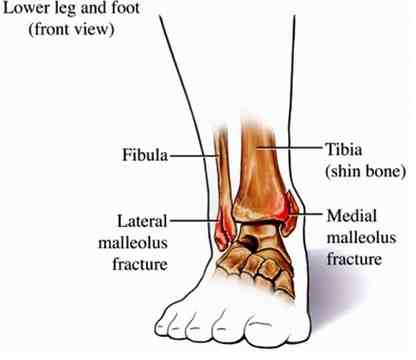 Picture 1 – Pic of broken ankle anatomy
Picture 1 – Pic of broken ankle anatomy
Image source – empowher.com
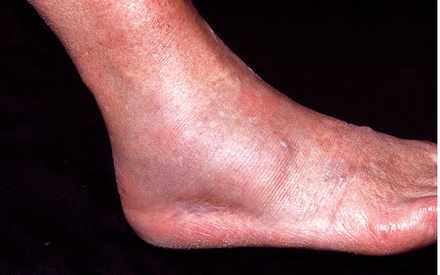
Picture 2 – Broken ankle showing swelling, redness
Image source – sciencephoto.com
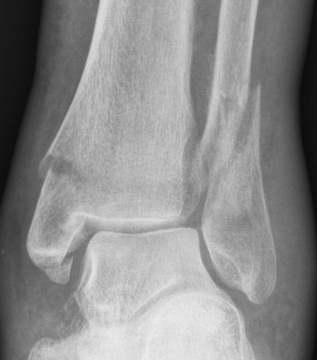
Picture 3 – X-ray showing broken ankle (tibia, fibula)
Image source – footankle.com
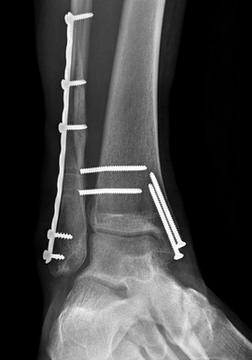
Picture 4 -External fixation of broken ankle (x-ray view)
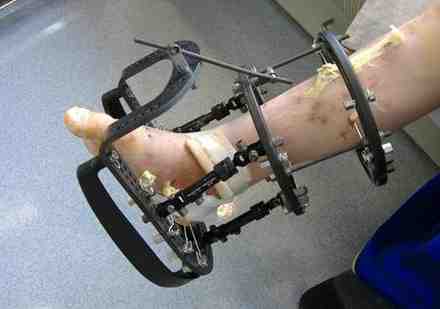
Picture 5 – Ring fixator for Broken ankle